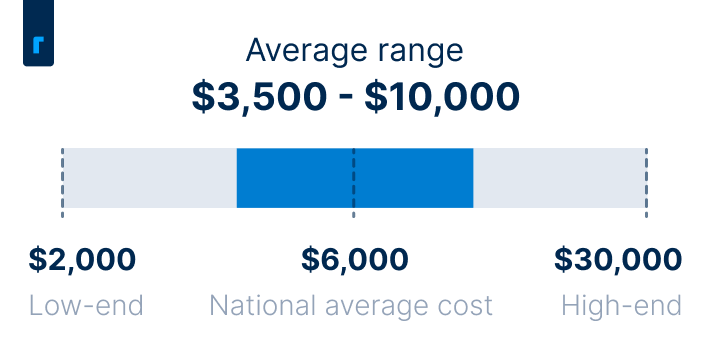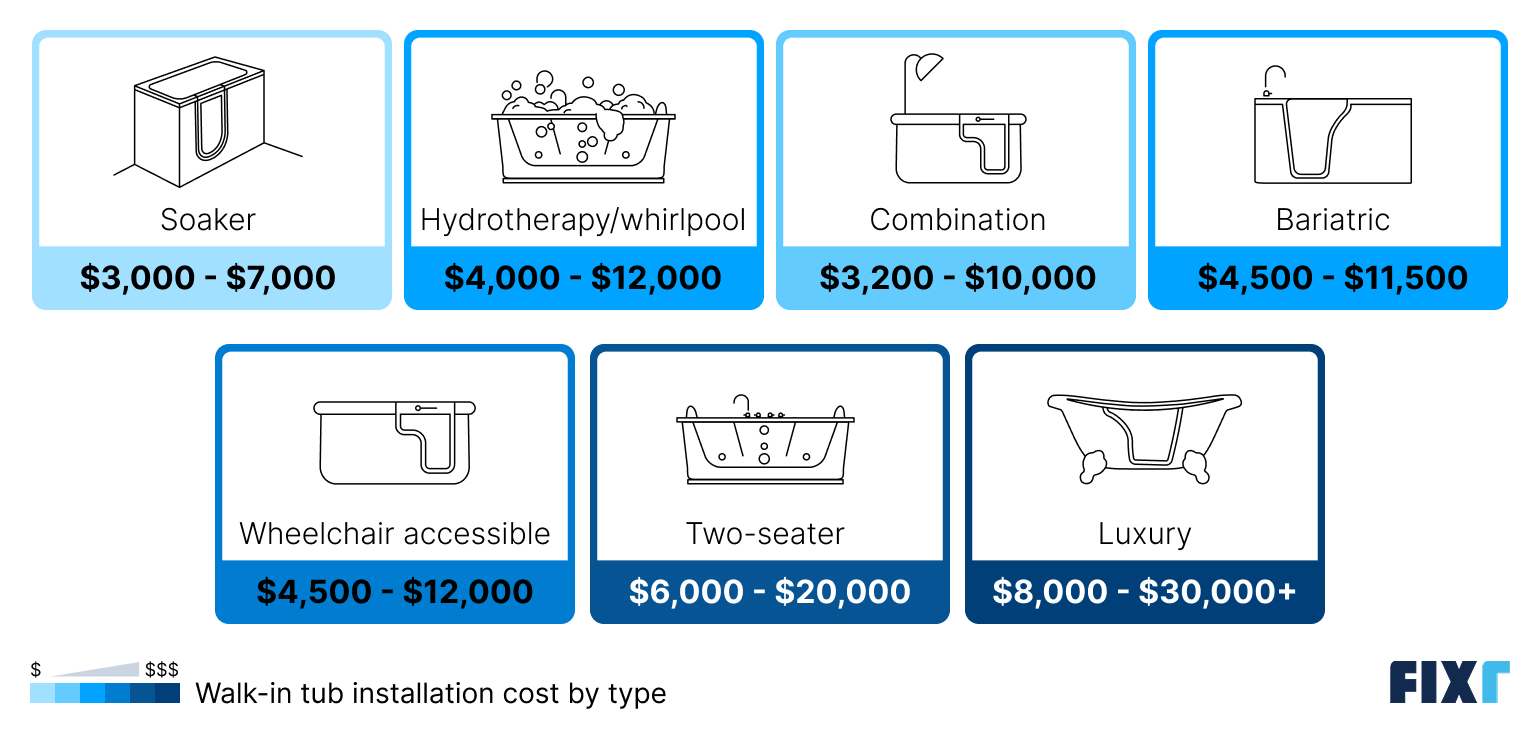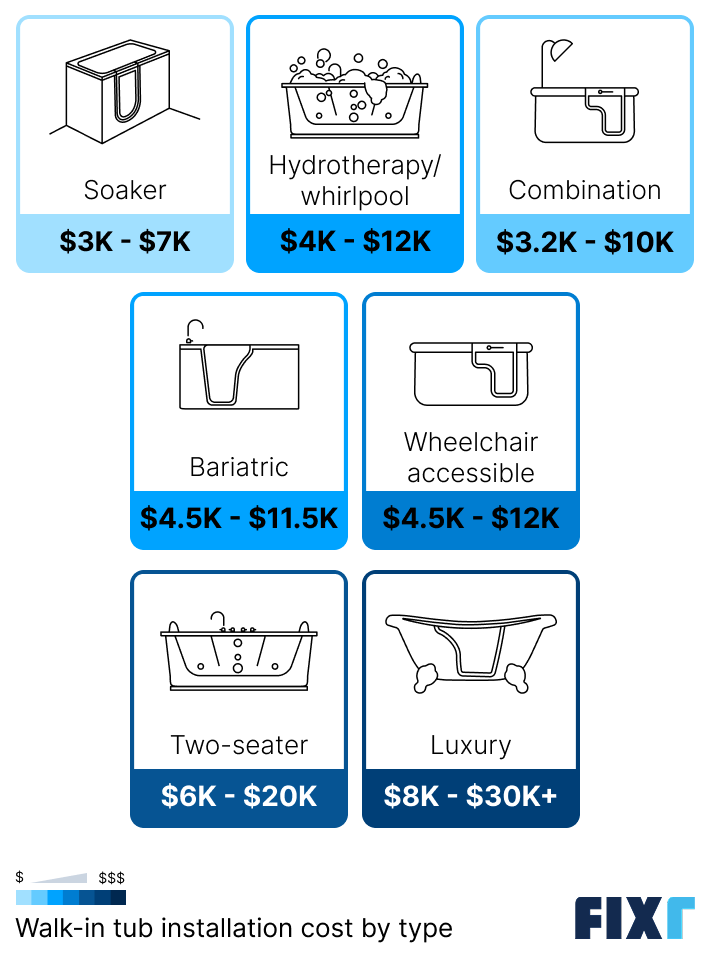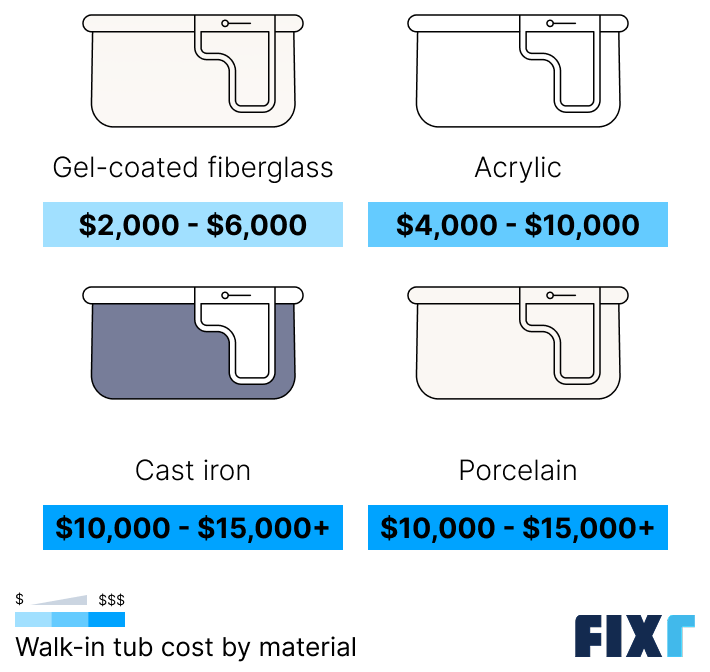Updated: October 24, 2025
Written by Dan Simms
Laura Madrigal is the Home Design Specialist at Fixr.com, dedicated to identifying and analyzing significant changes within residential design. She is the author of leading trends reports on interior design, kitchen, and bathroom, and her insights have been featured in publications like Realtor and the New York Post.
Learn moreReviewed by Laura Madrigal
Walk-in tubs can be revolutionary for those with mobility issues, providing far greater safety and independence than standard bathtubs and stand-up showers. For some people, walk-in tubs can make bathing possible again, while for others, it can mean improved comfort and self-sufficiency when it comes to bathing.
The national average cost of a walk-in tub is $6,000, and most projects total somewhere between $3,500 and $10,000. Prices vary mostly based on features, materials, size, and required bathroom modifications.
Walk-in Tub Installation Cost


Walk-in Tub Prices by Type
Much like with standard tubs, there are many different kinds of walk-in tubs you can choose from. A soaking tub, which has no jets or other special features, is the most common option and costs an average of $5,000. There are many other walk-in tubs you can consider if you have more room in your budget and are looking for added functionality.
Here’s a quick look at the different types of walk-in tubs and what they’ll cost.


Type of Walk-in Tub | Average Cost |
Soaker | $3,000 – $7,000 |
Hydrotherapy/whirlpool | $4,000 – $12,000 |
Combination | $3,200 – $10,000 |
Bariatric | $4,500 – $11,500 |
Wheelchair accessible | $4,500 – $12,000 |
Two-seater | $6,000 – $20,000 |
Luxury | $8,000 – $30,000+ |
Soaker Tubs
Soaker walk-in tubs have no special features aside from easy access through the walk-in door. These are the most affordable, totaling between $3,000 and $7,000 in most cases. They’re also the most common.
Hydrotherapy/Whirlpool Tubs
These walk-in tubs have air or water jets that provide therapeutic benefits for pain relief, improved circulation, and muscle relaxation. Expect a price range of $4,000 to $12,000 for this style.
Combination Shower and Tub
Combo walk-in tubs just have added safety and comfort features, like hold bars and handheld shower heads, and some have built-in seating. These cost between $3,200 and $10,000.
Bariatric
Bariatric walk-in tubs are oversized and often feature wide seating for individuals with larger body frames to ensure a comfortable and safe bathing experience. They cost between $4,500 and $11,500 to install, including materials and labor.
Wheelchair Accessible Tubs
Wheelchair accessible tubs provide maximum convenience and accessibility for wheelchair users. They cost $4,500 to $12,000 to install, are oversized, and have wider entrance points with no clearance for easy access.
Two-seater Tubs
Two-seater walk-in tubs cost between $6,000 and $20,000, depending on what other features are included.
Luxury Tubs
Luxury walk-in tubs can cost up to $30,000 to install, but they can include a wide array of features like aromatherapy, heated seats, and chromotherapy lighting for improved comfort.
Walk-in Bathtub Prices by Material
Most walk-in tubs are made of acrylic, which is the most common tub material, but you can also choose gel-coated fiberglass to keep costs down, or porcelain or cast iron for the longest-lasting tub possible.
Gel-coated fiberglass is the most affordable option, costing between $2,000 and $6,000 in most cases. This is also the least durable option, as the finish is prone to fading and cracking. Porcelain and cast iron are the most resistant to damage and can be reglazed for the longest lifespans possible. A walk-in tub using these materials can cost $10,000 to $15,000 or more, even if you just go with a standard soaker tub.
Acrylic strikes a good balance between the two, both in terms of upfront cost and durability. An acrylic walk-in tub will cost you between $4,000 and $10,000, in most cases.


Tub Material | Average Cost |
Gel-coated fiberglass | $2,000 – $6,000 |
Acrylic | $4,000 – $10,000 |
Cast iron | $10,000 – $15,000+ |
Porcelain | $10,000 – $15,000+ |
Walk-in Tub Installation and Labor Cost
In most cases, the installation labor for a walk-in tub will cost between $1,000 and $3,500, but this can vary widely based on your existing setup, your new tub’s material, and what, if any, changes you need to make to your bathroom to accommodate your new tub.
Labor costs will usually include removing and hauling away your old tub, moving the new tub into place, and connecting plumbing and electrical lines. However, costs will be higher if new plumbing or electrical lines need to be run, or if the bathroom requires major modifications to accommodate a larger tub or additional features.
Plumbers usually charge an average of $90 per hour, but prices can range from $75 up to $150, depending on experience and location. Electricians charge between $70 and $130 per hour, in most cases. If you have an idea of the work involved in installing your walk-in tub, you can use these hourly rates to get a rough estimate for what your installation will cost.
Upgrades and Add-ons
Walk-in tubs are a great option for improving safety and convenience, so many homeowners consider upgrades and add-ons that will enhance those areas. For others, walk-in tubs are just nice to have for comfort and luxury, and for those users, premium upgrades are an important consideration to get all-in estimates for the installation.
Upgrade Area | Upgrade/Add-on | Cost |
Safety | Anti-slip surfaces | $25 – $50 |
Grab bars | $25 – $350 each | |
Anti-scald faucet | $100 – $350 | |
Convenience | Handheld showerhead | $50 – $150 |
LED lighting | $100 – $500 | |
Quick-fill faucet | $150 – $500 | |
Rapid-release drain | $200 – $400 | |
Luxury | Aromatherapy | $200 – $300 |
Heated back rest | $300 – $500 | |
Water heater | $300 – $1,000 | |
Massage jets | $3,000 – $8,000 |
Safety Upgrades
For maximum safety, consider the following safety features for your new walk-in tub.
Grab bars: Grab bars give users something sturdy to hold onto while getting into and out of the tub. Wall-mounted and deck-mounted bars can cost $25 to $350 each.
Anti-slip surfaces: Many walk-in tubs include anti-slip surfaces for safety. If yours doesn’t, you can have a pro install a textured vinyl mat for $25 to $50.
Anti-scald faucet: Since you’ll have to sit in a walk-in tub while it fills, an anti-scald faucet can help avoid burns while you’re waiting for the tub to fill. These will cost $100 to $350 to add, depending on the quality.
Convenience Upgrades
Walk-in tubs are naturally more convenient than traditional tubs, but these add-ons can boost convenience even further.
Handheld showerhead: Handheld showerheads make bathing easier and more convenient. Expect to pay $50 to $150 to install a standard one in your walk-in tub.
LED lighting: You’ll pay between $100 and $500 to install a light fixture in your bathroom for better visibility.
Quick-fill faucet: A quick-fill faucet will reduce the time it takes your tub to fill, which is useful because you’ll have to get in the tub before you begin filling it. This add-on will cost you $150 to $500, but costs could climb higher if you need changes to your plumbing system.
Rapid-release drain: Since you’ll also need to wait for your walk-in tub to drain completely before you get out, rapid-release drains are highly convenient. Expect to pay between $200 and $400, but note that prices can climb higher if you need plumbing system changes.
Luxury Upgrades
For the most luxurious and premium bathing experience possible, you can consider these high-end upgrades for your walk-in tub.
Aromatherapy: Aromatherapy add-ons can bump up costs by between $200 and $300, but this feature makes bath time more relaxing and therapeutic.
Point-of-use water heater: A point-of-use water heater costs $300 to $1,000 to install, but it ensures you never run out of hot water when filling your walk-in tub.
Massage jets: Massage jets are more of a feature than an add-on, but upgrading to a model that includes massage jets will usually cost you $3,000 to $8,000 more.
Heated backrest: A heated backrest is the epitome of luxury while you bathe and can add $300 to $500 to your installation costs, including the electrical connection.
Additional Considerations and Costs
A walk-in tub is a big financial commitment, so it’s important to consider all of your options carefully. You should also consider the impact of a walk-in tub on home value and general bathroom accessibility before committing. Think about all of the following additional costs before hiring a pro to carry out the upgrade.
Brand: The walk-in tub brand you choose will play an important role in your costs. Budget options like Safe Step, Kohler, American Standard, and Meditub are more affordable, while premium brands like Jacuzzi, Boca, and Ella’s Bubbles include more safety and comfort features.
Tub size: The size of your walk-in tub will have a major impact on costs, with larger tubs always costing more for materials and labor. More importantly, oversized models may require bathroom remodeling or bathroom layout changes, which can significantly increase your costs.
Additional bathroom modifications: Some walk-in tubs can simply replace your existing tub with a safer and more convenient tub area. Expect costs to climb much higher if you need to move or install supply plumbing lines or add wiring for electric features, like jets.
Permits: Simply replacing your tub won’t require a permit, but you might need to consider permit costs if you need to make changes to your plumbing or electrical system. Permit costs can sit between $150 and $1,000, depending on how much work is involved.
Demolition and disposal: Most pros will include the cost of removing and hauling away your old bathtub, but some may charge separately, which will add to your total. Costs can increase if your installer needs to demo and remove other materials like tiling, cement backerboard, and other plumbing fixtures.
Maintenance and ongoing costs: Standard walk-in bathtubs will need regular cleaning, which may not be feasible for those who need walk-in tubs for accessibility. Bathroom cleaning services average between $75 and $150, so you may want to budget for regular services. Maintenance to keep mechanicals in good working order can add to that total.
Converting a shower to a tub. Costs typically range from $3,000 to $15,000, depending on the extent of plumbing, flooring, and layout changes. Smaller bathrooms may need rerouted pipes or wall removal, increasing costs. Since walk-in tubs hold more water, proper waterproofing and drainage are crucial. Optional upgrades like half-wall enclosures or tub-shower combos add versatility but also raise expenses.
DIY vs. Hiring a Professional
Installing a walk-in tub is a complex project involving plumbing, electrical, and structural work, so it’s best to hire a professional to install yours, even if you have a lot of DIY experience. The combination of water and electricity, in particular, can be extremely dangerous, and leaks are far more likely with a walk-in tub if you don’t get a perfect seal for the door.
Additionally, many manufacturers will void their warranties if the tub is not installed by a certified professional, which could mean higher repair and maintenance costs down the road, especially for electric components, like jets. To ensure safety, proper functionality, and long-term reliability, hiring a licensed and insured professional is the best choice.
How to Save on Walk-in Bathtub Costs
Installing a walk-in tub is a major investment, but there are a few things you can do to reduce your upfront cost:
Check for financial assistance: Look into government grants, rebates, and special financing programs. Veterans may qualify for grants from the U.S. Department of Veterans Affairs, such as the Home Improvements and Structural Alterations (HISA) grant. State and local programs may also offer assistance for home accessibility modifications. Some non-profits even offer grants or loans for accessibility upgrades for certain individuals.
Simplify your features: The cost range of a walk-in tub can vary significantly based on the features you choose. Think about the features you need, and then assess how much room you have in your budget for nice-to-haves.
Choose a standard model: A tub that fits your existing bathtub's footprint will cost less to install, as it requires fewer modifications to your plumbing, walls, and flooring.
Shop around and get multiple quotes: Get estimates from at least three different companies to find the best deal on labor. Compare the total price, including the tub and installation, and make sure to ask about any available discounts or promotions.
FAQs
Yes, walk-in tubs are specifically designed with safety being a top priority. All walk-in tubs feature a low step-in threshold for safety and comfort, and many also include built-in handrails and a textured or anti-slip floor to minimize the risk of slips and falls. You can choose models with other features for maximum safety, like anti-scald faucets and built-in seating.
One of the main disadvantages is the installation cost, which is often significantly higher than the cost to install a standard tub. Additionally, since you need to enter a walk-in tub through a door in the side, you have to get in before filling and wait for the tub to drain before exiting. This makes bathing more time-consuming and can lead to discomfort while you’re waiting.
Original Medicare does not typically cover the cost of a walk-in tub, as it is not considered durable medical equipment and instead an upgrade for convenience. With a prescription from a doctor, though, it’s possible that the cost could be covered. Additionally, some Medicare Advantage plans may offer partial coverage, and other programs like Medicaid and certain grants for veterans may provide financial assistance.
The total cost for a walk-in tub, including professional installation, usually ranges from $3,500 to $10,000. Your total will depend on the tub's features, brand, material, and any necessary modifications to your bathroom's plumbing or structure.
The cost of a walk-in tub for seniors and those with limited mobility can prove to be a worthwhile investment. While the upfront cost may seem high, it can be a more cost-effective long-term solution compared to the significant monthly costs of assisted living or professional in-home care. Beyond the financial aspect, the greatest value lies in safety, convenience, and independence, all of which a walk-in tub can provide.
